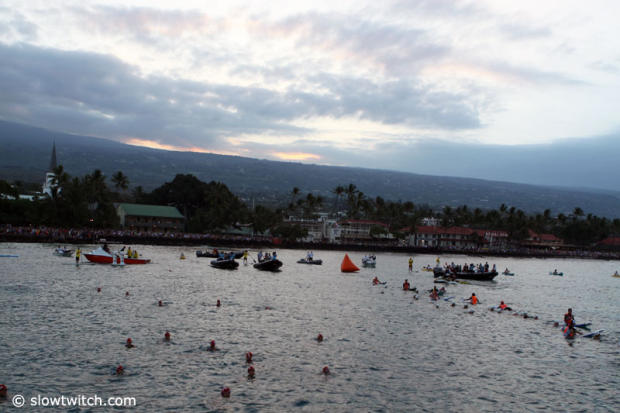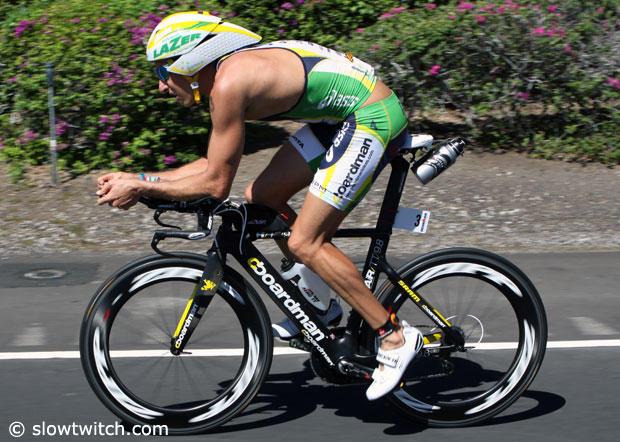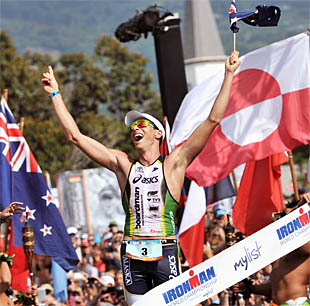Kona 2012 – by the numbers
Pete Jacobs, Luke McKenzie, and Faris Al-Sultan all played key roles during Saturday’s Ironman World Championship in Kona. These athletes were gracious enough to share their power data files and TrainingPeaks analyzed how the race went down, by the numbers.
For the past three years, the men's race at the Ironman World Championships unfolded in a predictable manner. An American would lead out of T1, a different American would lead into T2 and then one of two Australians would run across the line first. Although these generalizations held true for the past 3 years, the only thing you would've wanted to bet on in 2012 was Potts leading the swim. Rewinding to 6 months ago, every pro that raced yesterday was imagining an American assault led by Andy Potts out of T1 flanked by Lance Armstrong and Chris Lieto. This would have forced the pace to a new high on the bike and required the "runners" to risk more to stay in contact on the bike, or find an equally high pace on the run to make up the deficit.
A repeat of 2011 seemed likely again, with talk of a showdown between Chris McCormack, Craig Alexander and other pre-race favorites with more experience in Kona. A likely scenario still had Pete Jacobs on the podium, but not the top step.
At first it appeared 2012 would be no different from 2011 as Potts once again exited the water first. But the margin between Potts and the chase group was less than a minute this year, whereas in years past he enjoyed a lead of several minutes heading into the bike. Pete Jacobs was in the chase group with other strong swimmers including fellow Australian Luke McKenzie.
At this point, on the bike, the race began to diverge from expectations, and what took place over the following four and a half hours surprised everyone.
McKenzie took off with the group of early favorites including Alexander, Al-Sultan, Marino Vanhoenacker, Paul Matthews, Michael Raelert, Potts and Jacobs. At around 6 miles, he passed Potts with an aggressive 12-second surge of 523W (7.2 w/kg) and all this datacame via his SRAM Quarq.
Despite a few attempts by Alexander to lead, McKenzie continued to press the pace for the next 37 miles mostly in the lead, collecting the Timex bike prime. This was a tough hour and a half effort off the front, where McKenzie averaged 288W (4 w/kg) and 25.5 mph, and put in his Peak 1-hour Power of the day at 295W (4.1 w/kg). This was nearly 11% higher than his overall average power output for the day of 265W (3.7 w/kg).


As McKenzie was leading, Pete Jacobs was working hard himself, putting in his Peak 20 Minute Power of the day of 317W (4.5 w/kg) and averaging 27.3 mph to catch up with McKenzie around mile 45. At this point Jacobs asserted his presence within the group, taking over with a 578W burst and jumping to the front. (Jacobs uses a Quarq power meter) He led for nearly 20 more minutes heading into the Hawi climb. However he was closely marked by Vanhoenacker and eventually Jacobs would fall back to let Vanhoenacker lead the group up the climb to Hawi. Jacobs and McKenzie stayed close to Marino during the 5-mile 480-foot climb, each averaging over 300W for about 18 minutes to keep up (4.4 w/kg for Jacobs, 4.2 w/kg for McKenzie). After the turn-around, 70.3 World Champion Sebastian Kienle passed the front group and soon led Vanhoenacker in a breakaway, establishing a 50-second lead over the group by mile 60. McKenzie dropped back from the lead, putting eventual third place winner Frederik Van Lierde and Jacobs towards the front of the chase pack.
With Vanhoenacker and Kienle setting a fast pace off the front it would have been reasonable to expect Jacobs to fall back and allow Van Lierde, Bockel or Al Sultan to lead the chase, especially considering the effort he put in during the first half of the ride and his confidence in knowing he had the previous year’s fastest marathon times.
Jacobs held a steady effort of 268W (3.8 w/kg) between mile 70 and 112 to maintain his front position and minimize the loss to Vanhoenacker. This effort minimized losses to Vanhoenacker to 8 minutes and earned Jacobs a new experience from his previous three years at Kona: 2nd off the bike.


Throughout the race Faris Al-Sultan showed his experience on the Big Island and proved that he still had the ability to possibly repeat his 2005 victory. Comparing the three files between McKenzie, Jacobs and Al-Sultan we could assume Al-Sultan would have had the freshest legs since his SRM power meter shows he only spent 23 minutes above threshold, while Jacobs and McKenzie each spent over 45 minutes riding above threshold. On the climb to Hawi, Faris rode more conservatively, averaging 4 w/kg whereas and McKenzie rode 4.2 wk/g and Jacobs averaged 4.4 watts/kg.
Variability Index analyzes how smooth or consistent an athlete’s power output was during a race. A ride with a lower index produces similar power with less fatigue and will set the athlete up for a better run. Below we see that Faris’ ride was the “smoothest” among the three, with McKenzie’s being the “punchiest”.
Comparing the Variability Index
Faris Al-Sultan VI 1.01
Pete Jacobs VI 1.04
Luke McKenzie VI 1.06
Faris’ smoother pacing strategy resulted in lower average watts/kg than Jacobs (3.8 w/kg vs 4.0 w/kg) but still kept him in the top 5 off the bike, only 46 seconds behind Pete. In 2011, when the conditions allowed for record-setting times, Faris finished the marathon in 3:01. In 2012, despite harder conditions, Faris leveraged his pacing strategy for a 2:56 marathon.


Many wondered if Jacobs’ strong bike may undermine his run. However, this new position for Pete also afforded a slower pace on the run since he wasn’t having to pull back the usual 8-10 minutes on class runners like Alexander, McCormack or Andreas Raelert. He was able to hold off the field with a 2:48 marathon (he’s run in the range of 2:40 in 2010 and 2011). Likewise Faris was able to hold onto a top 5 position on the run despite having a group of 2:50 marathoners chasing him. McKenzie’s impressive but hard efforts on the bike did appear to have cost him, and he went from 8th place coming into T2 to 24th overall, with a 3:20 marathon.
Direct number comparison








Start the discussion at forum.slowtwitch.com